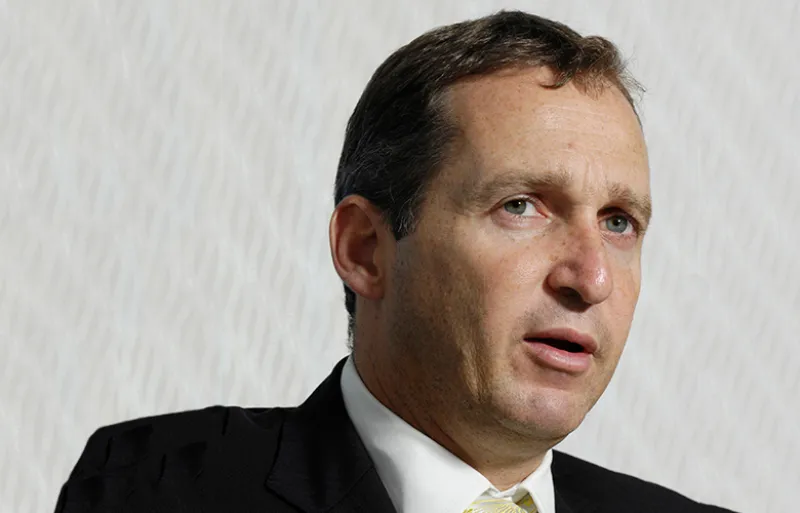"Five pounds in the jar," quips Andrew Formica, the co-chief executive of Janus Henderson, when I refer to his company by its old name of Henderson. It's lunch time on a Wednesday at Sosharu, a Japanese restaurant with an ultra-precise approach to food in relaxed dark wood and moody blue surroundings.
Sosharu suits Formica, who appears smiling in a grey woolen suit and open necked shirt, exactly on time. He remains faultlessly affable even when challenged on his pay. But he picks up on the outdated firm name. After spending months traveling between London and Denver to hammer out the so-called "merger of equals" between Janus and Henderson, he's had time to practice his lines.
We regard the menu. Formica is tickled by the Japanese fried chicken, but sticks to fish - it reminds him of growing up in Sydney, where he would get fresh sashimi off the boat at the harbor. It pays to know how to use chopsticks now that 12.9 percent of his company is owned by Japan's Dai-Ichi Life Holdings.
The merger stunned the asset management industry. Rivals caught a whiff of panic as two mid-sized asset managers, both squeezed by the regulatory environment, joined together to create an investment house that, as of December 2017, had a market capitalization of around $7 billion, and $371 billion of assets under management. Yet Formica had been looking for his Janus moment for ten long years, ever since he pitched for the chief executive position in 2008, aged 37.
He was born in Sydney, Australia, to a family of teachers, and sponsored by AMP Capital through an economics degree at Macquarie University. The desire to offer a hand-up to other hungry dealmakers from less privileged backgrounds would lead him to start Investment 2020, a career program that has helped 2,000 young people into the asset management industry, 90 percent of them from state schools.
After the surprise resignation of his predecessor, Roger Yates, Formica was asked to present his vision for Henderson, which was originally founded in the U.K. in 1934 to manage the estate of Alexander Henderson, the first Lord Faringdon. The dust had barely settled after the collapse of Lehman, yet Formica spotted a "buyer's market" for asset management companies that became part of his 10-year strategy for putting Henderson among the BlackRocks and the Schroders.
The acquisitions swiftly followed. In 2009, he spied an opportunity to shore up Henderson's position in the U.K. with New Star, whose debt had been spiraling since the market downturn. Then he looked to expand the firm's European business with a rescue merger with Gartmore, another weakened player, in 2011.
In the U.S., Henderson made some small acquisitions in Milwaukee and created a successful retail business that brought in $3.5 billion of new money in 2015 -- growing 38 percent year-on-year. But Formica recognized that Henderson would have to replicate that kind of growth ten times and for ten years to achieve the scale necessary for any real impact in the U.S. So he looked to speed up the process the best way he knew how: with a strategic acquisition of another weakened player. Janus had recorded its first inflows in five years in 2014 thanks to the arrival of Bill Gross from PIMCO. It had just $195 billion on its books at the time of the deal.
The "merger of equals" granted Henderson 57 percent of the shares, compared to Janus's 43 percent. Janus moved its headquarters away from Denver and into the Henderson office on Bishopsgate in the City of London, while Richard Weil, Janus chief executive, swapped Denver's blue skies for the smog of London to become co-chief.
Formica says the integration of the two companies has gone better than expected. As part of the merger, Henderson delisted from the London Stock Market in favor of New York. "In terms of global competitors, there are far more over there," he says. "Over here you have a couple, Schroders, for example, but in the U.S. you have BlackRock, T. Rowe, Franklin [Templeton Investments]. These firms are well-known for being global."
A cufflink that looks like an EU flag peeks out of his suit jacket as he reaches for the soft shell crab tempura. The cufflinks were a present from Brussels from his eldest son. Formica fears Brexit will limit his three children. "I like that the U.K. is an open market," he says. "I'm from Australia and I was made welcome here, despite not going to school here. So when a lot of the press around Brexit was about being more closed, that worries me."
As for the business, he expects to build out company headquarters in Luxembourg and Ireland, though the global base will stay in London. "This is a trading country, it will be fine," he says with a sigh. "But it could have been better."
Analysts at Morgan Stanley declared the Janus Henderson merger the start of "a Darwinian moment" as active asset managers group together to reap efficiencies in the battle against cheaper and arguably more profitable passive funds. Formica says he's not only out to compete on size - he wants the respect of his clients and is prepared to make sacrifices to keep it. Plus he can't foresee a future when Janus Henderson will offer passive management, putting it out of the league of the big guns. But in an age where European regulation like MiFID II (the second edition of the Markets in Financial Instruments Directive) is squeezing the margins, scale can mean savings - for Janus Henderson, a reported $110 million in the first year.
If things are rosy internally, onlookers' eyebrows have arched over the board's decision to award bumper pay raises to both Formica, who nearly tripled his salary to $7.6 million, and Weil, who took home $9 million, even though Janus Henderson lost $10.2 billion in 2017 and a further $8.4 billion in 2016. Formica defends the packages, at least temporarily: "We're in an unusual structure where we are also running additional costs. But it is a transitionary period that will last three years. After that we will look again." Perhaps that merger won't look so equal when the transitory period ends.
I ask him if he worries that extremely high compensation packages make chief executives like himself seem out of touch with the very people he is trying to reach through Investment 2020. He says the bigger problem is raising awareness among graduates of opportunities in asset management. "A lot of my compensation is driven by long-term investing," he says. "I don't like measuring our results on a yearly basis. They should be measured on five- or even 10-year structures."
Do I sense another plan? "China," he says. "China will be in the next 10-year plan but that will be difficult for our industry because the rules are changing rapidly as it is opening up."
This dealmaker can bide his time. After 25 years at Henderson, Formica counts himself among long-serving industry execs like Michael Dobson, who ran Schroders for 14 years, and Martin Gilbert, at Standard Life for 30. For now, Formica must focus on proving the wisdom of his latest deal. "The potential of Janus Henderson is enormous," he says. "The reality is, the market is yet to see it."







